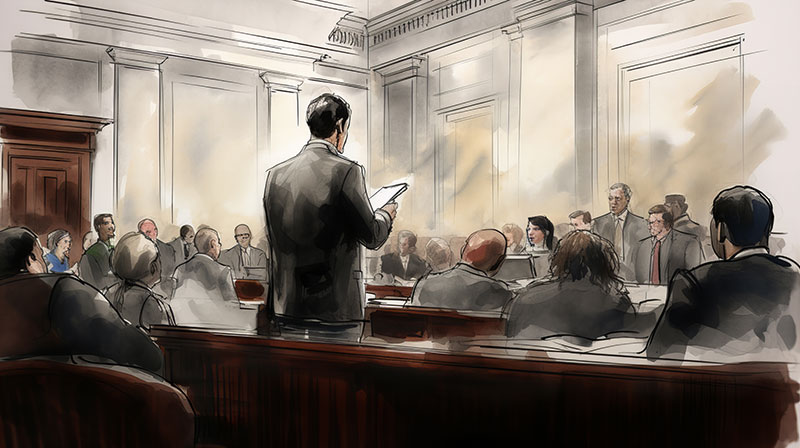In the realm of legal proceedings, the ability to clearly present complex information can be the difference between winning and losing a case. This is where courtroom animation comes into play, offering a dynamic way to convey facts and evidence that resonate deeply with jurors. Here, we explore how courtroom animations can transform trial presentations, making them more understandable and engaging.
Understanding Courtroom Animation
Courtroom animation refers to the use of 3D and 2D animations to visually depict legal arguments or recreate incidents within a court setting. These graphics are not just embellishments; they are strategic tools that can help juries and judges better understand the nuances of a case.
- Types of Courtroom Animations: From forensic reconstructions to simulations of medical procedures, the scope is vast.
- Purpose: Primarily, these animations aim to clarify, explain, and persuade, offering visual solutions that words alone might fail to convey.
The Role of Animation in Legal Proceedings
Animations in the courtroom serve multiple functions, each enhancing the litigation process in distinct ways:
- Enhanced Understanding: They break down complex information into digestible visuals.
- Increased Engagement: Jurors are more likely to engage with dynamic visuals than static images or verbal descriptions alone.
- Memory Retention: Visual aids help jurors remember details more effectively.
The Impact of Trial Graphics on Jury Decisions
Research suggests that visuals can significantly impact a juror’s understanding and, consequently, their decisions. The strategic use of graphics in trials, therefore, can influence verdicts, making the integration of animations a critical consideration for legal teams.
- Visual Evidence: How animations make abstract concepts tangible.
- Decision Influence: Demonstrative evidence can subtly sway jury perceptions and decisions.
Legal Animation and Admissibility
Not all animations will automatically be permissible in court. The admissibility of these visual aids depends on several factors:
- Accuracy and Relevance: The animation must accurately represent factual evidence and be directly relevant to the case.
- Non-prejudicial: It should not be overly prejudicial, meaning it must not unduly influence the jury by depicting scenarios in a misleading way.
LawFX: A Leader in Courtroom Animation
When it comes to crafting expert legal animations, LawFX stands out with its comprehensive approach. Specializing in both 3D and 2D animations, LawFX provides animations that are not only accurate but also tailored to the specifics of each case.
- Expertise: LawFX combines legal knowledge with advanced animation technology to create clear and compelling presentations.
- Customization: Every animation is custom-made, ensuring that it aligns perfectly with the legal narrative and evidence presented.
Real Cases Transformed by Courtroom Animation
To illustrate the effectiveness of courtroom animations, consider these real-life applications:
- Accident Reconstruction: Detailed re-creations of accidents that help jurors understand the sequence of events.
- Medical Malpractice: Animations that clarify complex medical procedures and potential errors in treatment.
Future Trends in Courtroom Animation
As technology advances, so too does the field of legal animations. Future trends include:
- Virtual Reality (VR): Immersive experiences that could take jurors directly to the scene of an incident.
- Increased Accessibility: As animation technology becomes more cost-effective, smaller law firms and cases with limited budgets can also benefit from these powerful tools.
Frequently Asked Questions for Courtroom Animation
1. What is courtroom animation?
Courtroom animation, also known as legal animation or forensic animation, involves creating graphic representations in 3D or 2D to depict scenarios relevant to legal cases such as accidents or crime scenes within a courtroom setting.
2. How can courtroom animation benefit legal professionals?
Courtroom animation has supported numerous legal professionals by providing visually engaging and accurate trial graphics that help in conveying complex information to judges, juries, and other stakeholders in a clear and compelling manner.
3. What types of cases commonly use courtroom animation?
Courtroom animation is frequently utilized in a variety of cases, including personal injury, medical malpractice, aviation accidents, and other legal cases where visual aids can enhance the presentation of evidence and arguments.
4. How is courtroom animation created?
Courtroom animation is typically produced by animation teams comprising animators and graphic designers who work closely with legal experts to develop accurate and compelling trial graphics tailored to the specifics of each case.
5. What factors determine the admissibility of courtroom animation in court?
The admissibility of courtroom animation as demonstrative evidence in court is subject to various factors, including relevance, authenticity, and compliance with legal standards, which may vary depending on the jurisdiction and the nature of the case.
6. How can courtroom animation help in presenting complex information to a jury?
Courtroom animation can assist in simplifying complex concepts and presenting them in an engaging and understandable manner to jurors, helping them grasp the key points of a case more effectively and reach a more informed verdict.
Conclusion
In the legal arena, where every detail can tip the scales of justice, courtroom animations are more than just visual aids; they are essential tools that enhance understanding, engagement, and memory retention. Firms like LawFX are at the forefront of this field, offering specialized services that can significantly impact the outcomes of trials through professional and scientifically accurate animations. Whether for accident reconstruction, medical malpractice, or other types of litigation, animations provide a visual narrative that can help clarify the facts and lead to fairer, more informed verdicts.
In essence, as the adage goes, a picture is worth a thousand words—perhaps in the courtroom, it’s worth even more.



